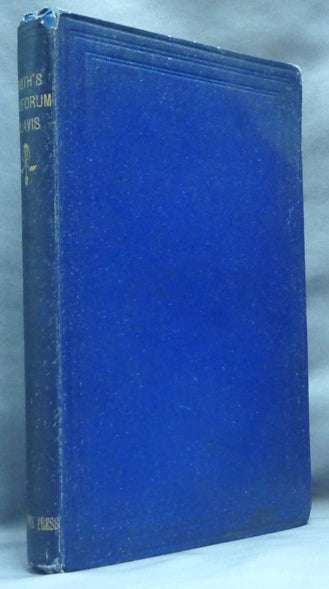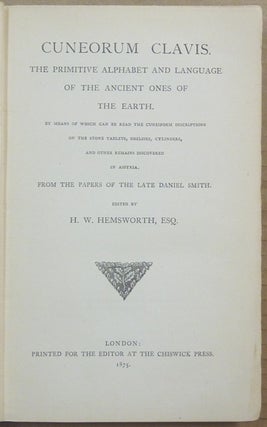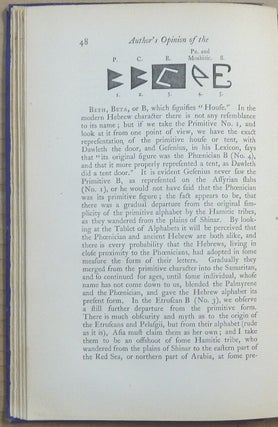Cuneorum Clavis. The Primitive Alphabet and Language of the Ancient Ones of the Earth; by Means of Which Can Be Read the Cuneiform Inscriptions on the Stone Tablets, Obelisks, Cylinders, and Other Remains Discovered in Assyria; from the papers of the later Daniel Smith
London: Chiswick Press, 1875. First Edition. Hardcover. Large octavo. xxiv + 160pp + ix (actually x) diagrams/charts, 3 of which are fold-outs. Original blue cloth with blind borders on covers and gilt titling to spine. B&w illustrations and plates. The author, Daniel Smith, was an eccentric amateur linguist, whose interest in the language of ancient Assyria was fired by viewing the displays at the British Museum of the discoveries made by Layard at Nimrud and of Nineveh. Smith observed what he thought were similarities between the cuneiform letters and those of the Greek alphabet, and began work to reconstruct a proto-alphabet, which he eventually decided was Hebrew, but written in triangular shapes. In 1851 some mysterious circumstance caused Smith to flee London for Australia, where he eventually published the first of the fruits of his studies in 1864. Convinced that the literary and scholarly world would embrace his genius, he returned to England in 1867, only to find himself dismissed and ignored. He responded by haunting the meetings of relevant learned societies, and accusing the experts of being frauds who deliberately ignored his discoveries to cover their own ignorance. E. A. Wallis Budge, felt Smith to be typical of a certain "class of time-wasters" and revealed that Smith was the model for a most peculiar individual given the name "Daniel Fagg" in Walter Besant's novel "All Sorts and Conditions of Men." Smith evidently made a lasting, and not at all positive, impression on Budge who wrote of him at length in "By Nile and Tigris." In this Budge described Smith as "a little, shabbily-dressed man, with dark, piercing eyes and a shaggy beard, who haunted the office of the Palestine Exploration Fund and the British Museum. Time after time he had been turned out of the former building, but he could not be turned out of the Museum because it is practically a public institution, and when not engaged in harrying the officials, he sat in the Egyptian Gallery, over one of the hot-air gratings, and meditated upon the willful ignorance and blindness of the officials and the magnitude of his great discovery. ... He believed that the Jews, Hittites, Assyrians, Babylonians, Medes, Persians, and Egyptians all spoke one and the same language, and that anyone who possessed enough knowledge of Hebrew to use a Hebrew dictionary, and was acquainted with the "Common Alphabet" which he had invented, could read the languages of all the peoples mentioned above, and many others, .... He professed to be able to read every inscription in all the Galleries of the Museum. He stopped Mr. (later Sir) C. T. Newton one day, and, pointing to a Greek inscription, told him that it was wrongly labeled, and that it contained a copy, of one of St. Paul’s love-letters to the lady Theda and her reply. Mr. Newton was not credited by his colleagues with the ability to " suffer fools gladly," and great was his indignation on this occasion. ... The man’s belief in his “ discovery ” was genuine enough, and he was firmly convinced that all the learned Societies and all the experts in the British Museum were in league against him. Argument was out of the question, and all that any one could do was to sit still and listen till patience gave out. I saw him once again with Birch, and this time he had brought with him a huge bundle of manuscript, which was the book he had written to explain the ” Common Alphabet.” (It may be mentioned in passing that the letters were formed by series of triangles arranged in different positions.) Many charitable folk had subscribed for his book, and paid their subscriptions in advance; and those who have any recollection of Birch will not be surprised to hear that although he regarded the "Common Alphabet" as nonsense, he helped its hungry inventor by subscribing for two copies and paying for them on the spot." Smith was evidently close to publishing the definitive version of his theories "Cunoreum Clavis" when he died, and his papers were passed to one H. W. Hemsworth, who published them in the present form. A remarkable example of delusional scholarship. The boards appear to have had varnish applied to them, which was a relatively common preventative used in the late nineteenth and early twentieth centuries to protect against insects, dusts, etc. Spine darkened, corners and spine ends bruised and chafed, minor loss of cloth at upper spine with a short tear at front gutter. Page edges darkened, bookplate on front pastedown, endpapers cracked at gutters but hinges are holding solidly. Light damp mark to upper corner of front blank, pages toned with a few lightly creased corners - text unmarked. Overall a tight, clean about VG copy. Scarce. Item #64547
Sold





